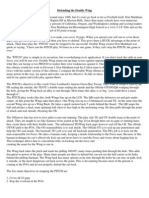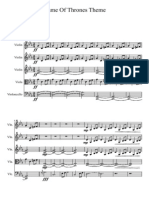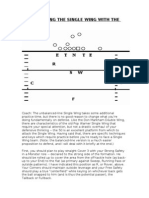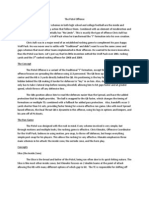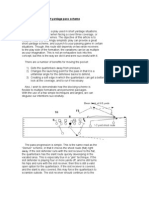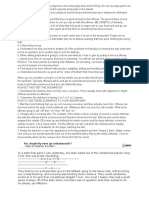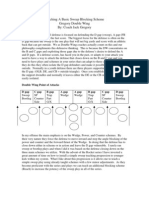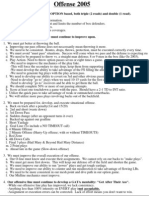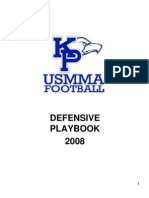0 ratings0% found this document useful (0 votes)
77 viewsFlexible Offense by
Flexible Offense by
Uploaded by
CoachHuffcoachhuff
Copyright:
© All Rights Reserved
Available Formats
Download as DOCX, PDF, TXT or read online from Scribd
Flexible Offense by
Flexible Offense by
Uploaded by
CoachHuff0 ratings0% found this document useful (0 votes)
77 views84 pagescoachhuff
Copyright
© © All Rights Reserved
Available Formats
DOCX, PDF, TXT or read online from Scribd
Share this document
Did you find this document useful?
Is this content inappropriate?
coachhuff
Copyright:
© All Rights Reserved
Available Formats
Download as DOCX, PDF, TXT or read online from Scribd
Download as docx, pdf, or txt
0 ratings0% found this document useful (0 votes)
77 views84 pagesFlexible Offense by
Flexible Offense by
Uploaded by
CoachHuffcoachhuff
Copyright:
© All Rights Reserved
Available Formats
Download as DOCX, PDF, TXT or read online from Scribd
Download as docx, pdf, or txt
You are on page 1of 84
Flexible Offense by Gerry Watkins
"Flexiblity Above All"
My Offensive Philosophy
Flexibility above all things. Some offenses are based on speedy receivers, some
on big backs. This system is predicated on flexibility. If you have speedy
receivers you should throw. If you have a big back you should run. A good
system allows the offensive coordinator room to customize the fit for his
players.
To this end I've tried to keep the design as amorphous as possible and not
devote the system too much to any one tactic or style. "Be like the nature of
water" is something martial artists are often told. Be flexible, maintain the
ability to fit into any container. To any one style is to deny yourself the
advantages of all other styles.
Unfortunately, there are always trade offs. The trade-off we make in our effort
to maintain flexibility is complexity. The ability to do a lot of things requires a
lot of terminology. The trick is to maintain system flexibility without crushing
players' minds.
To this end, the terminology I use is all designed around an "interchangeable
parts" approach. That is to say that the entire play is assembled piece by piece
during the call with no specific piece dependent on the inclusion of another. To
avoid confusion as to who's assignment is who's the system incorporates word
association (words beginning with Z for the Z receiver, Y for the Y, R for the
R, etc). So while there can be a lot of calls on a single play, each player knows
(by word association) what sounds/letters to listen for and he can ignore
anything that doesn't apply to him.
This offense is also very concerned with maintaining surprise. Any offense's
most basic advantage is the fact that it knows the plan of attack and the defense
does not. A good system will endeavour to preserve this advantage as long as
possible. No play is dependent on any particular formation and a single play
can have one of a multitude of very minor changes (motions, alignments, etc.)
attached to it. The idea is for all plays to look as similar as possible until the
critical moment when you spring your attack.
By maintaining flexibility and keeping your true intentions masked until the
moment of execution, the defense is forced to defend a large number of
possibilities rather than a fewer number of tendencies.
Finally, along with flexibility and surprise a good system should be effecient.
That is to say, a well designed offense is large in theory and trim in practice.
While this system is intended to be comprehensive on paper, it is up to the
individual coaches to tailor it to the realities of their situation. If you don't have
a fullback who can lead block, don't bother installing the 10 series. If you don't
have 2 viable tight ends, don't bother installing the J personell package.
Without the proper personell you lack the capability to effectively run those
packages, so you do nothing to increase your operational flexibility. You also
lack the credibility to threaten the defense using those packages, so you gain no
advantage in tactical deception either.
Remember the goal is REAL flexibility not FALSE flexibility. Maximize the
offense you can use not the offense you can draw. Install what is useful and put
the rest back on the shelf until you can use it.
Formations and Personel
A Group (2 RB, 3 WR, 0 TE)--> Alice
B Group (1 RB, 4 WR, 0 TE)--> Bob, Benton
C Group (0 RB, 5 WR, 0 TE)--> Charlie
D Group (2 RB, 2 WR, 1 TE)--> Daniel
G Group( 1 RB, 3 WR, 1 TE)--> Grant, Gary, Gavin
H Group (0 RB, 4 WR, 1 TE)--> Harold
I Group (2 RB, 1 WR, 2 TE)--> Ian
J Group (1 RB, 2 WR, 2 TE)--> Jenny, Jerome
"K Group" (0 RB, 3 WR, 2 TE)--> Kevin
NOTE: Names for packages and formations are largely arbitrary. Pick any
names you believe can be easily remembered by the players, with a few
exceptions. The letters E and F were omitted because they are associated with
other things (several words beginning with E are shifts for the backfield and
words beginning with F are used to direct the fullback). In order to minimize
friction, package and formation words beginning with X, Y, Z, T, F, R or E
should be avoided, as should names of animals. These associations are used for
other variations.
Alignment and Spacing Rules
NOTE: The outermost receivers set the formation. The spacing rule for slot
receivers is to "split the distance between the man outside you and the tackle".
Pre-Snap Adjustments
By using specialiazed calls to adjust the alignments of individual players we can greatly
increase the number of looks the defense may see on any one play. This contributes to
our ability to deceive and disguise. Furthermore, judicious use of alignments can
maximize the effects of certain schemes. For example, by moving the Z in with a "zebra"
call, we make it easier for him to put pressure on the interior of the defense with a
shallow route.
Adjustments are broken down into two subcategories: alignments and motions.
Alignments go into effect as soon as the team breaks the huddle, whereas motions must
be signalled by the QB. Both are associated by sound (words beginning with Z for the Z-
receiver, T for T, etc), and all alignments are animal names.
NOTE: Adjustments are often explained in terms relative to the actor. For example, when
"Zero" motion tells the Z to motion to the far sideline, the word "far" refers to the sideline
furthest from the Z.
Zebra
Z closes his split to 1x1 from the next man to his inside.
NOTE: This can be useful when the Z is running inside routes (slant, shallow, dig,
square, etc), in order to facilitate an shorter, easier throw for the QB (bench, out, etc), or
to create a "bunch".
Tiger
T opens his split to 1x1 from the next man to his outside.
NOTE: This can be a used as an addition to the Z-slash screen, to bring a LB out of the
box, or to create a "bunch".
Turtle
T closes his split to 1x1 from the next man to his inside.
NOTE: This can be used to bring T in as an extra blocker on running plays, an extra
protector on pass plays, to isolate an outside receiver, or to facilitate more leverage
against inside coverage.
RB Alignments
"Rabbit Strong" - RB lines up 1x1 off the last man on the strong side of the line.
"Rabbit Weak" - RB lines up 1x1 off the last man on the weak side of the line.
"Raccoon Strong" - RB lines up behind the strong side tackle, 5-yards deep.
"Raccoon Weak" - RB lines up behind the weak side tackle, 5 yards deep.
NOTE: Rabbit is useful to facilitate an easier pass release for the RB. Raccoon can be
used to change the look of certain running plays (without changing any assignments) or
to allow for easier pass blocking.
FB Alignments
"Falcon Strong" - FB lines up 1x1 off the last man on the strong side of the line.
"Falcon Weak" - FB lines up 1x1 off the last man on the weak side of the line.
"Frog Strong" - FB lines up behind the strong side guard, 5-yards deep.
"Frog Weak" - FB lines up behind the weak side guard, 5 yards deep.
NOTE: Frog is one of the most useful adjustments for the 10-series, both to facilitate lead
blocking and release on play-action passes. Falcon is useful anytime the FB has to block
the end or release.
Z Motions
"Zip" - To the hip of the next man to his inside.
"Zap" - To the hip of the first man on the near side of the line.
"Zig" - To the hip of the last man on the far side of the line.
"Zag" - To the QBs hip and then back to the hip of the first man on the near side of the
line.
"Zoom" - To the hip of the last receiver on the far side of the line.
"Zero" - To the far sideline.
NOTE: There are quite a few motions listed here. Of course, an efficient coordinator will
install only those he intends to use. Zip is useful in the same ways as Zebra. Zap, Zig,
Zag can be used to convert Z to a slot receiver or to bring him into a position to pass
block or crack. Zoom and Zero are used primarily for misdirections or to ascertain
coverages.
T Motions
"Tip" - To the hip of the first man on the near side of the line.
"Top" - To the hip of the last man on the far side of the line.
"Tag" - To the QBs hip and then back to the hip of the first man on the near side of the
line.
"Tax" - To the inside hip of the X.
"Toy" - To the inside hip of the Y.
"Taz" - To the inside hip of the Z.
"Trick" - To the far sideline.
NOTE: There are quite a few motions listed here. Of course, an efficient coordinator will
install only those he intends to use. Tip, Top, and Tag are useful in the same manner as
Turtle. Tax, Toy, and Taz are used in the same manner as Tiger, mostly to create
bunches. Trick is used mostly for misdirection and to ascertain coverages.
RB Motions
"Rip Strong/Weak" - To the hip of the first man on the strong/weak side of the line.
"Rat" - To the inside hip of the T.
"Relax" - To the inside hip of the X.
"Roy" - To the inside hip of the Y.
"Razor" - To the inside hip of the Z.
"Roll Strong/Weak" - To the strong/weak sideline.
NOTE: Rip is useful in the same ways as Rabbit. Rat, Relax, Roy, and Razor are used to
create bunches. Roll is used primarily for misdirection.
NOTE: Motioning the RB out of the backfield can be used to free up more running room
for the FB.
FB Motions
"Flow Strong/Weak" - Lateral motion to the guard-tackle gap on the strong/weak side of
line.
"Front Strong/Weak" - To the hip of the first man on the strong/weak side of the line.
"Fax" - To the inside hip of the X.
"Fly" - To the inside hip of the Y.
"Faze" - To the inside hip of the Z.
"Freak Strong/Weak" - To the strong/weak sideline.
NOTE: Flow is useful in the same ways as Frog. Front is useful in the same ways as
Falcon. Fax, Fly, and Faze are used to create bunches. Freak is used primarily for
misdirection.
NOTE: Motioning the FB out of the backfield can be used to free up more running room
for the RB.
The Running Game
Hole Identification
Read Point - RB
The read point is the first step for the RB, the place from which he receives the ball. The
read point remains the same no matter what alignment the RB starts from.
Read Point - FB
QB Footwork
QB Footwork - Option Package
Running From Two-Back Formations
Running From One-Back Formations
Option Package (Two-Back)
The 3-Step Passing Game
There is no distinction between outside and slot routes (with the exception of the Arrow
route, which can only be run from the slot, and the Out, which can only be run from the
outside). 30 series routes can be combined in any order with the play call proceeding
from the outside in using the first letter of each route.
30
Series
Route
Chart
NOTE:
While the
system
allows
for any
combinati
on to be
made, the
OC must
use
common
sense and
not run
two
players to
the same
sport (i.e.
32 OA,
LF, FA,
etc)
EX.
30-1
NOTE:
The first
letter is for the outside receiver, the second for the slot. (Figure 30-1 Bob Right- 32
SG)
EX.
30-2
NOTE: If
there is a
third
receiver
to one
side the
third
letter
designate
s his
route.
(Figure 30-2 Charlie Right- 32 SGA)
5-Step Passing Game
The outside route is the route explicitly called which implies a complimentary route for
the next man inside, and for the backside receivers. The following chart shows the
packaging of routes.
Call - Playside Slot - Backside Slot - Backside Outside
Shallow - Over - Go - Square
Fin - Over - Go - Square
Curl - SAO - Replace - Brake
Bench - Choice - Replace - Brake
Dig - Go - Replace - Brake
Hook - SAO - Replace - Brake
Square -SAI - Go - Brake
Go - Choice - Replace - Brake
Post - Choice - Replace - Brake
PC -
SAI -
Replace
- Brake
Outsi
de
Route
s
Inside
Route
s
Backfi
eld
Route
s
Brake
Route
NOTE:
The "brake route" is a simple read. If, when the receiver reaches 10 yards, the DB is
closer than 5 yards, then the receiver will run the "go". If the DB is giving the receiver 5
or more yards of space, then the receiver will curl up at 12 yards.
Choice Route
NOTE: The choice route is a key component to this passing game, but it requires an
intelligent route runner capable of reading the defense without half-stepping his route.
The goal is to attack the middle of the field. The "choice" is at what depth. If the receiver
sees a deep safety in the middle of the field (ie versus cover 3 or man-free) then he will
run the dig underneath that safety. If he sees no deep safety in the middle (ie versus cover
2 or straight man) then he will run the post.
Repla
ce
Route
NOTE:
The
"replace"
route is
the basic
dump off
route
designed
as a last
resort and
to hold
the LBs
from
doubling
the
deeper
routes.
The
receiver
is
running
to the spot where the middle linebacker began the play.
EX. 50-1
NOTE:You can adjust any receivers route individually by calling it specifically. (Bob
Right 52 All-Go, T-SAI)
EX.
50-2
NOTE: If
more
than 2
receivers
to one
side, the
Inner
Receiver
must be
called
explicitly
.
(Benton
Right 52
Z-Dig T-
SAO)
EX.
50-3
NOTE:
Any
receivers
(inside or
outside
the call)
with out a
designate
d or
implied
route run
a Go. (In
Benton
Right 52
Y-Dig
the Z
runs a
Go)
EX.
50-4
NOTE:
The
routes
can also be changed by adjusting the subject of the call (as seen in this and the next two
examples). Three subject modifiers (Double, All, and Mirror) can be used for this
purpose.
For example, if the call is Bob Right 52 Z-Go, the routes frontside-to-backside read Go-
Choice-Replace-Brake. However, if the call is Bob Right 52 Double Go, then both
frontside
receivers
will run
the called
route, in
this case
a "go".
EX.
50-5
NOTE:
Similarly,
if the call
is Bob
Right 52
All Go,
then all
receivers
will run
the go.
EX.
50-6
NOTE:
Lastly, a
call of 52
Mirror
Go will
direct
both
outside
receivers
to run the "go" and both slots to run the complimentary "choice" route (thus creating the
"mirror effect where both sides are running the same packages).
Out Of Pocket Passing Game
Playside Outside - Playside Slot - Innermost - Backside Slot - Backside Outside
"PASS"
Go - Over - SAO/Shallow - Drag - Post
"COMEBACK"
Comeback - Corner - SAO/Shallow - Drag - Post
Comeback Route
NOTE: The "comeback" is a hard push outside to turn the defender and then a hard break
back and to the outside, coming back towards the throw.
Drag
Route
NOTE:
The Drag
replaces
the
replace as
the
default
backside
slot route
in out of
packages.
8 yards
with a
slight
lean to
the inside
and then
accross
the field
aiming
for 18-20
yards on
the
opposite
sideline.
Corne
r
Route
NOTE:
The
"corner"
route is
similar to
the over
route, but
instead of
breaking
towards
the
sideline,
under the
outside route, the receiver will break over the outside route and aim for the back corner of
the
endzone.
"Pass"
NOTE:T
he "pass"
call is a
route
package
for up to
all five
receivers.
The QB
will read
from the
playside,
in (Z to Y
to T to R
to X) and
hit the
first open
man.
(Charlie
Right 82
Pass)
"Pass"
(with
3
backsi
ders)
NOTE: If there are 3 receivers on the backside the innermost will run a shallow to fill the
zone where the SAO route would have been. The read is still playside-in.(Charlie Right
81 Pass)
Come
back
NOTE:
The
"comebac
k" call is
a route
package
for up to
all five receivers. The QB will read from the playside, in (Z to Y to T to R to X) and hit
the first
open
man.
(Charlie
Right 82
Comebac
k)
Come
back
(with
3
backsi
ders)
NOTE: If there are 3 receivers on the backside the innermost will run a shallow to fill the
zone where the SAO route would have been. The read is still playside-in ("Charlie Right
81
Comebac
k")
Bad
Call
NOTE:
Of
course,
you can
still call
any
regular
50s route
package,
but bare
in mind some will work better than others because the QB's throwing position has
changed. The example to the right shows a bad idea because the QB would have to throw
back opposite his run to the middle of the field. ("Alice Right 214 Z-Square")
Good
Call
NOTE:
The OC
should
always be
aware of
what his
calls
mean in
terms of
throwing
lanes.
Unlike
the play above, this is a good example of using play-action to set up an easy throw.
("Alice
Right
Falcon
Str 314
Pass X-
Bench")
Count
er
Boots
NOTE:
There are
not 100s
or 200s
off of
counter action. Bootlegging off the counter requires a "counter" call to differtiate it from
a normal 300 bootleg. Lastly, don't forget to incorporate the other adjustment and passing
options. (Bob Right Toy 313 Counter All-Go T-SAO).
Screen Packages
NOTE- Screens are associated with the letter "S". Patterns beginning with "s" are usually
screens (the exceptions being "square" and "shallow").
NOTE- Basically the system runs several variations on 2 types of screens: an outside-in
screen (shown with the Z) and an inside-out screen (shown with the T).
NOTE- These screens are not position specific. You could run an X-slash (provided there
was another receiver to his in side) or a Y-Slip (provided there was another receiver to his
outside). Nevertheless, in most offense, the T and Z will probably be the screen
recipients.
NOTE- T-Slice is not so much a screen as a hybrid of a counter and a shovel pass. Its
included here because it doesn't really go anywhere else.
Pass Protection Schemes
3-Step
Protec
tion
(30s)
.
5-Step
Protec
tion
(50s)
.
Sprint
Out
Protec
tion
(80s)
.
Play-
Actio
n
Protec
tion
(100s)
.
Roll
Out
Protec
tion (200s)
.
Bootleg Protection (300s)
.
Count
er
Boot
Protec
tion
(300
Count
ers)
.
Tango
NOTE: A "Tango" call will tell the T to pass protect. However, an adjustment call (either
a motion or alignment) will be needed to put him in position. ("Bob Right Turtle Tango
52 Z-Shallow")
XRay
NOTE: An X-Ray call will tell the X to remain in as an extra pass protector. This can
only be used when X is in tight. (Gavin Right XRay 52 All-Go R-Flare)
Yanke
e
NOTE: A
Yankee
call will
tell the Y
to remain
in as an
extra pass
protector.
This can
only be
used
when Y
is in
tight.
(Grant
Right
Yankee
31 GS)
Zulu
NOTE: A
"Zulu"
call will
tell the Z
to pass
protect.
However, an adjustment call (either a motion or alignment) will be needed to put him in
position.(
Benton
Right Zig
Zulu 52
X-
Hook)
Max
NOTE: A
"Max"
call will
keep both
the Y and X in to pass protect. "Max" is only available in the I, J, and K personnel
groups.(Jerome Right Max 52 Mirror-Curl R-Flat)
Overload Blocking
The OC may find it desirable to further concentrate blockers at the point of attack by
using receivers as other than stalk-blockers. To this effect there are two WR block calls:
Hard and Crack. Hard directs the receiver to block the defensive end closest to him. The
Solid call tells both slot receivers to block their respective DEs (in essence a double Hard
call). Crack sends the WR into the center of the defense to block the closest LB. While
this package uses the Solid, Hard, and Crack calls against unblocked defenders, they can
also be used to double team particularly tough defenders (as I will eventually demonstrate
in another sample package).
Grant Rt Zebra Tip 44 Counter Solid Z-Crack
NOTE: The Hard on the backside DE allows you to run the play against a 50, which you
could not do without it. The Hard on the frontside means that the playside guard will
most likely be going against a DB instead of the DE. The Crack call inhibits the LB
pursuit.
Gavin
Rt
Zap
42
Sweep
Z-
Hard
T-
Crack
NOTE:
Same principles as above, except we don't Hard the X because that would be a waste.
Most backside ends are not going to make the play on a toss sweep, so we feel it is better
to leave the X with his original assignment of cutting off backside pursuit from the CB
(just in
case the
RB
breaks a
long one
or cuts
back).
Daniel
Rt
Freak
Weak
43 G-
Lead
X-Hard
NOTE: We motion the F out to draw away the CB. Then use the X-Hard to free the
pulling guard to take on the LB pursuit.
Daniel
Rt Zip
44 G-
Kick
Z-
Crack
NOTE:
Using the
crack call
here
effectivel
y switches the blocking assignments of the Z and FB. Which is better for both, since the
Z now
has a
blindside
shot at a
LB and
the F will
be
matched
against a
smaller
DB.
Jerom
e Rt
Solid
48 Draw Blast
NOTE: Using the Solid call guards against the risk that the ends will not be fooled by the
draw.
No Huddle Package
I like the no-huddle because it really puts the pressure on the defense. In this section I put
together a small no-huddle package. All plays are run from Bob Right to avoid any
confusion. The shotgun can be automatic for the no-huddle or called with the adjustment
"Gun".
Please note that this is NOT a 2 minute drill package (I'll put one of those up later). This
is intended to pressure the D, not to protect the clock. Note also, 1) no adjustments (other
than the shotgun) are made, no motions, no alignments changes, 2) I don't use any pulling
linemen in order to preserve their energy, 3)each of the pocket pass plays are paired with
a run, and all are off of play-action, which plays to our goal of maximizing deception.
Bob
Rt
142
Y-Fin
R-
Flare
NOTE: I
like this
as part of
a huddle
because
its got plenty of variety. The Y-Fin is an easy throw and can result in big yards after the
catch. At the same time, the Y-Fin keeps the LBs off the X-Square (good for third and
long) and
the R-
Flare.
Plus
there's
always
the Z on
the go
route for
a deep
threat.
Bob
Rt
145
T-Hook X-Bench
NOTE: The T-Hook is good for the no-huddle package because its a fairly easy throw for
the QB and it gets a good chunk of yardage. I add the X-Bench incase the CB starts to
cheat towards the inside to help with the hook. Of course, you've always got the standard
backside combo of the replace and the brake.
Bob
Rt
148
All-
Curl
NOTE:
This is
included
for 4
basic
reasons
1) its the simple read, 2) its an easy throw, 3) its good for 3rd-and-longs, 4) its a good
opportuni
ty for
WRs to
get yards
after the
catch (if
they
create
proper
seperatio
n).
Bob
Rt 45
Base
NOTE: The shotgun adds a kind of "draw effect to the most basic (and most easily
executed)
running
play from
the one-
back.
Bob
Rt 42
Toss
NOTE: This play will become more and more effective as the no huddle wears down the
LBs. WR
blocking
is a must
though.
Bob
Rt 48
Draw
NOTE:
The draw
is easily
executed
and a
good way
to keep
the LBs
honest.
Bob
Rt 80
Mirror
Pass
R-Flat
NOTE:
Which
side this
play goes
to is the QBs pre-snap choice which he wil call at the line (for the benefit of the line and
the RB).
Bob
Rt 80
Mirror
Come
back
R-Flat
NOTE: Which side this play goes to is the QBs pre-snap choice which he wil call at the
line (for the benefit of the line and the RB).
Wing-T Adaptation
Off-setting the RB (like in a Wing-T) can add a new dimension to an offense by changing
the timing and angles in the running game and facilitating a more aggressive out-of-
passing
game for
the QB.
Daniel
Rt
Racco
on
Wk
28
Trap
The
quick
trap is
employed
in this
package
because it
sets up
the
option
back
towards
the RB.
Daniel
Rt
Racco
on Wk 41 Trap Opt
By optioning towards the realigned RB the play will develop faster and could lead to a
big play. The X's release block on the CB is key.
Daniel
Rt
Racco
on
Wk
Freak
Wk
41
Toss
Similar to
the option, I like the toss here because it develops extra quick and can catch the weakside
of the
defense
off-
guard.
Daniel
Rt
Racco
on
Wk
15
Lead
The lead
is the bread-and-butter of the two-back running game. The alignment change adds almost
a sort of draw effect since the RB is actually taking a step back to hit his read point.
Daniel
Rt
Racco
on
Wk
14
Count
er Y-
Crack
By
running away from the realignment we slow down the development and create a sort of
sweep
action.
This
would be
a good
call for a
cutback
running
specialist.
Daniel
Rt
Racco
on
Wk
Zip 14 G-Lead Z-Crack
Again, by running away from the realignment we slow down the development and create
a sort of sweep. The runner should be looking to bounce outside since the Z is coming
down on the LBs with a crack.
Daniel
Rt
Racco
on
Wk
Zip 81
Pass
X-
Bench
R-Flat
Sprinting out towards the realignment allows the RB to get into the pattern immediately
and allows for a fast developing play. QB is reading the CB. Secondary read is the FS,
who is being "high-low"-ed by the Z and Y. If the QB has a strong arm, this can be a big
play back
to the Z
in the
deep
middle.
Daniel
Rt
Racco
on
Wk
Freak
Wk
31 HJ
Since every package should have a quick pass, we motion the fullback out for a quick
hitch. The Jump route to the X can be big if you have an athletic TE.
Daniel
Rt
Racco
on
Wk
Freak
Wk
141
Doubl
e Go
R-Flare
Working off the Toss, we freeze the defense with play-action and then throw away from
the FS (F
or X on
deep
routes),
or dump
to the
RB-Flare.
Daniel
Rt
Racco
on
Wk
116
Z-Square F-Flat
Again, suck up the defense with the play-action and then read the SS for the Square-SAI
decision. Look for the defense to possibly forget about the FB after the fake.
Daniel
Rt
Racco
on
Wk
Count
er 314
X-
Corne
r
Lots of misdirection in the backfield here. Counter, and then boot back to the weak side,
reading outside-in (X to Y). The Z-Post can be hit for a big play, but the QB must have
an
exception
al arm.
Ideally,
the read
should be
quick
(Look X-
Look Y-
Run it!).
Daniel
Rt
Racco
on
Wk Zip 214 Comeback F-Flat
The QB is rolling right behind the RB fake and pressuring the outside of the defense. The
Z is motioned in to make the defense worry about the crack, and to allow for more
seperation on the comeback route. Again, the read is outside-in.
Motion to Trips
Motioning to trips is a good move for 3 reasons. 1) it changes the stregnth of the
formation which forces the defense to adjust on the fly 2)it allows you to flood the trips
side of
the field
3) it
distracts
the
defense
from the
weak
side.
Grant
Rt Zig
Z-
Hard
46
Base
Here the
motion is
used to
draw the
SS away
from the
point of
attack.
Grant
Rt Zig
Solid
43
Count
er
Here the motion gives us an extra blocker on the playside.
Grant
Rt Zig
Solid
41
Speed
Opt
The
motion
combined
with the
Solid call
turn the
speed
option
into a
load
option.
Grant
Rt Zig
42
Toss
Similar to
the 46
base, we
use the motion to draw attention to the strongside and then use the quick toss back to the
weakside.
Grant
Rt Zig
51
All-
Curl
T-
SAO
As you might notice in the other sample packages, I like curls because they're easy
throws
and easy
reads.
This is
simple,
flood the
zone and
throw
wear the
SS isn't.
Grant
Rt Zig
Count
er 343
Pass Y-Corner
More misdirection, bootlegging back away from the motion. If the big play to the Y isn't
there,
you've
got a 3-
tiered
cross
(post-
drag-
shallow)
coming
from the
backside.
Grant
Rt Zig
81
Pass
The sprintout pass is a good play to have in any package. I like to run it off the motion
because it gives the Z a running start into his route and lets him get to the outside that
much faster.
Grant
Rt Zig
Zulu
142
X-
Shallo
w Y
Post
Drawing
attention
to the Z, and then passing to the others. In-out on the SS (shallow and over), and a hi-low
on the
LBs (post
and
shallow).
Grant
Rt Zig
Yanke
e 31
GSF
Good
quick
pass. The
read is the man over the T (check the X in pre-snap). This works well in concert with the
screen
(Z-Slip)
because
the two
look so
similar.
Grant
Rt Zig
31 Z-
Slip
Quick screen to the motion man who gets a running start on the defense. (Note: playside
tackle must delay the end just a litte, before moving to the backer)
Bunch Passing
When multiple receivers start their routes very close to each other its called "bunching".
In this system the "animal" shifts (Tiger, Zebra, etc) and motions are used to create
bunches. Bunch passing can be useful to confuse the defense (especially in the case of
man
coverage)
and to
free up
receivers
on deep
routes.
Alice
Rt
Zebra
Fly
144
Z-Dig
F-Up
Zebra and Fly create the bunch. The Y clears, the Z pressures the inside, which should
leave the F open down the sideline. If the safety overflows to the sideline to pick up the
up, the
Dig will
be open.
Daniel
Rt
Falco
n Str Zebra Roy XRay 52 Z-Hook R-Up
Similar to the previous example, but this time the read is a high-low in the flat between
the SAO and the Up. Once again, if the defense overflows to the outside, comeback to the
hook in
the
middle.
XRay
keeps the
tight end
in for
extra
blocking.
Alice
Rt
Frog
Wk
Zebra
Razor 52 Z-Square Y-Up
Another variation on the same theme. However, this time the motion makes the Y the
innermost
receiver
so he will
run the
Up.
Jenny
Rt
Zebra
Trick
XRay
52 Z-
Fin R-
Flat
This time
the bunch
created in close with the idea of a shorter completion. The T clears the CB, making it a
in-out read between the Z and the RB. If all the defenese sucks up on the short passes,
then the
Y should
be open
deeper on
the over
route.
Bento
n Rt
Zebra
Toy
32
NGA
Three
step passing can be especially effective out of a bunch. The Y clears, leaving an in-out
read
between
the T and
Z.
Bob
Rt
Zebra
Toy
32
SJF
Very
similar to
the previous example, this should also be effective against zone as it creates a high-low in
the flat in addition to an in-out.
Grant
Rt
Zebra
Razor
32
HAG
As with
the Z-Fin
this is an
excellent
play for
short yardage. If the Z is not open immediately upon his break, then look for the T (who
also had a
benefit of
a running
start into
his
route).
Charli
e Rt
Gun
Zebra
Tiger
Rip
Str 82
Z-Bench T-Slip
The bunch doesn't have much affect here (except perhaps to give the Z more room to the
sideline), but rather serves as a presnap distraction for the defense.
You might also like
- Defending The Double WingDocument14 pagesDefending The Double WingJason GamezNo ratings yet
- A20 PDFDocument8 pagesA20 PDFGuillermo Ramirez100% (2)
- Lutheran High Missouri Pistol Offense 2009Document411 pagesLutheran High Missouri Pistol Offense 2009CoachHuff100% (1)
- BHS Defensive PlaybookDocument19 pagesBHS Defensive PlaybookAlvin Rischel100% (3)
- Pelini InstallDocument75 pagesPelini Installsplitbacks100% (4)
- Football: Learn to Play Football - The Ultimate Guide to Understand Football Rules, Football Positions, Football Statistics and Watch a Football Game Like a Pro!From EverandFootball: Learn to Play Football - The Ultimate Guide to Understand Football Rules, Football Positions, Football Statistics and Watch a Football Game Like a Pro!Rating: 4.5 out of 5 stars4.5/5 (2)
- Game of Thrones Theme For Strings PDFDocument6 pagesGame of Thrones Theme For Strings PDFRuth Harvey100% (4)
- Defending Single Wing With 50 FrontDocument9 pagesDefending Single Wing With 50 FrontEdmond Eggleston Seay III100% (7)
- Mustang Pistol 1 of 3 Mechanics of The OffenseDocument24 pagesMustang Pistol 1 of 3 Mechanics of The OffenseSeth Drennan67% (3)
- 46 GutsDocument14 pages46 GutsGone Fishing100% (1)
- 4-3 Nebraska Install - PeliniDocument75 pages4-3 Nebraska Install - PeliniSaltFork100% (5)
- The Pistol OffenseDocument3 pagesThe Pistol Offensejustin_bell_61No ratings yet
- 2009 Youth Spread Rev2Document74 pages2009 Youth Spread Rev2Adan Echeverria100% (2)
- G DefenseDocument6 pagesG DefensebrittchrNo ratings yet
- Diamond Playbook OffenseDocument5 pagesDiamond Playbook OffenseRyan Barnhouse0% (1)
- Coaching Basketball: 30 Set Plays and Quick Hitters for the 1-4 High AlignmentFrom EverandCoaching Basketball: 30 Set Plays and Quick Hitters for the 1-4 High AlignmentNo ratings yet
- The Pistol Offense: by Derek A. "Coach" Wade Brought To You byDocument33 pagesThe Pistol Offense: by Derek A. "Coach" Wade Brought To You bywahoobobby100% (5)
- Bunch OffenseDocument8 pagesBunch OffenseCoachHuffNo ratings yet
- Single Wing Playbook by Coach RolyDocument20 pagesSingle Wing Playbook by Coach RolyCoachHuffNo ratings yet
- Misita How To Believe in Nothing and Set Yourself FreeDocument165 pagesMisita How To Believe in Nothing and Set Yourself FreeEsdfsd Sdfs100% (1)
- Win With The Pass The Spread Running GameDocument47 pagesWin With The Pass The Spread Running GameMalik ShaheedNo ratings yet
- Sprint OptionDocument9 pagesSprint OptionJohn Anderson100% (3)
- Sonny Dykes and Tony Franklin Air RaidDocument6 pagesSonny Dykes and Tony Franklin Air RaidJerad BixlerNo ratings yet
- DefenseDocument14 pagesDefenseCoachHuff100% (1)
- MHS Freshmen Offensive Playbook 2016Document26 pagesMHS Freshmen Offensive Playbook 2016anon_192462014No ratings yet
- Mazzone Offense - Protecting Base ConceptsDocument4 pagesMazzone Offense - Protecting Base Conceptsjimy45No ratings yet
- The Lead DrawDocument6 pagesThe Lead DrawCoach Brown100% (1)
- Wide Tackle 6Document13 pagesWide Tackle 6Marcus Upton100% (1)
- 46 DefenseDocument6 pages46 Defenserbgainous2199No ratings yet
- Switch Route R&sDocument9 pagesSwitch Route R&scoachrji100% (1)
- 557 Skills and Drills - OLDocument131 pages557 Skills and Drills - OLAnwar Brooks100% (4)
- NU LBDocument23 pagesNU LBmunichrangersNo ratings yet
- Re: Anybody Ever Go Unbalanced??: Reply #4 Yesterday at 4:20pmDocument13 pagesRe: Anybody Ever Go Unbalanced??: Reply #4 Yesterday at 4:20pmSwanton BulldogsNo ratings yet
- Dutchmen Pistol Offense 2007Document110 pagesDutchmen Pistol Offense 2007Елена Нельсон100% (2)
- 50 Rover DefenseDocument11 pages50 Rover DefensecoachnunnNo ratings yet
- Indy School - Linebackers PDFDocument5 pagesIndy School - Linebackers PDFDalvan MandelaNo ratings yet
- Woodelf Playbook: Tao Parkour StyleDocument9 pagesWoodelf Playbook: Tao Parkour StyleAntonio Hernández PeñaNo ratings yet
- Stopping The Power RunDocument6 pagesStopping The Power Runcoachjuniorb1No ratings yet
- Add Some Bunch To Your PlaybookDocument5 pagesAdd Some Bunch To Your PlaybookFballGuru100% (1)
- Teaching Sweep Blocking Scheme by Jack GregoryDocument6 pagesTeaching Sweep Blocking Scheme by Jack GregoryMichael Schearer100% (3)
- 2002WashingtonStateDocument232 pages2002WashingtonStateЕлена Нельсон100% (1)
- A. Our Offense Will Continue To Be OPTION Based, Both Triple (2 Reads) and Double (1 Read)Document36 pagesA. Our Offense Will Continue To Be OPTION Based, Both Triple (2 Reads) and Double (1 Read)Michael SchearerNo ratings yet
- GMC Defense Overview 2010Document33 pagesGMC Defense Overview 2010jonesdw32No ratings yet
- This Is Part 1 of A 2Document121 pagesThis Is Part 1 of A 2Heitor Medeiros100% (4)
- Zone Play Coaching Points Alex GibbsDocument12 pagesZone Play Coaching Points Alex Gibbspanthercoach54No ratings yet
- Youth Wing-I - Ted SeayDocument13 pagesYouth Wing-I - Ted SeayEdmond Eggleston Seay III100% (11)
- 2008 Merchant Marine DefenseDocument342 pages2008 Merchant Marine Defensesplitbacks100% (6)
- Cover 2 BeatersDocument25 pagesCover 2 BeatersCoach G100% (2)
- 4-4 D TerminatorDocument24 pages4-4 D Terminatortoramsfan8632No ratings yet
- 4-2-5 Away Side Run SupportDocument17 pages4-2-5 Away Side Run SupportMark Jackson100% (3)
- Spread Attack Chris Brown SmartFootballDocument44 pagesSpread Attack Chris Brown SmartFootballlinoderte33No ratings yet
- Rugger Practice and Tactics - A Manual of Rugby Football TechniqueFrom EverandRugger Practice and Tactics - A Manual of Rugby Football TechniqueNo ratings yet
- Doubles Domination: The Best of the Best Tips, Tactics and StrategiesFrom EverandDoubles Domination: The Best of the Best Tips, Tactics and StrategiesNo ratings yet
- No Holds Barred Fighting: The Ultimate Guide to Submission WrestlingFrom EverandNo Holds Barred Fighting: The Ultimate Guide to Submission WrestlingRating: 5 out of 5 stars5/5 (1)
- Playing Basketball: An Arm Chair Guide Full of 100 Tips to Getting Better at BasketballFrom EverandPlaying Basketball: An Arm Chair Guide Full of 100 Tips to Getting Better at BasketballNo ratings yet
- Kickboxing: Cut Kicks, Knees, Elbows, Sweeps: From Initiation To Knockout: Kickboxing: From Initiation To Knockout, #7From EverandKickboxing: Cut Kicks, Knees, Elbows, Sweeps: From Initiation To Knockout: Kickboxing: From Initiation To Knockout, #7Rating: 5 out of 5 stars5/5 (1)
- Effective Man To Man Offenses for the High School Coach: Winning Ways Basketball, #2From EverandEffective Man To Man Offenses for the High School Coach: Winning Ways Basketball, #2No ratings yet
- Flex Bone OffenseDocument51 pagesFlex Bone Offensejonesdw32No ratings yet
- 5dws JM DbdwsDocument22 pages5dws JM DbdwsCoachHuffNo ratings yet
- Bash OffenseDocument5 pagesBash OffenseMichael SchearerNo ratings yet
- Ultimate Youth Football Practice Plan: Ages 13-15Document19 pagesUltimate Youth Football Practice Plan: Ages 13-15CoachHuffNo ratings yet
- Practice Plans Coach Parker 2008Document35 pagesPractice Plans Coach Parker 2008CoachHuffNo ratings yet
- Youth Run GameDocument11 pagesYouth Run GameCoachHuffNo ratings yet
- 2009 Practice Plans 1-6Document6 pages2009 Practice Plans 1-6CoachHuffNo ratings yet
- Excel Practice SchedulekeepDocument13 pagesExcel Practice SchedulekeepCoachHuffNo ratings yet
- Practice and Game Organization PDFDocument17 pagesPractice and Game Organization PDFJoshua J Jackson100% (1)
- 1979 University of Mississippi Split Back Veer OffenseDocument198 pages1979 University of Mississippi Split Back Veer OffenseCoach Brown100% (7)
- Single Wing Offense Playbook 2.0Document24 pagesSingle Wing Offense Playbook 2.0CoachHuffNo ratings yet
- Single Wing in A WeekDocument14 pagesSingle Wing in A WeekCoachHuffNo ratings yet
- 2002 Single Wing PlaybookDocument16 pages2002 Single Wing PlaybookCoachHuffNo ratings yet
- 2024 Cambridge Exams Center Number: QA009 Provisional TimetableDocument2 pages2024 Cambridge Exams Center Number: QA009 Provisional Timetableomarkbkb2007suiNo ratings yet
- Proof of Identity/Proof of Date of Birth: Primary SecondaryDocument1 pageProof of Identity/Proof of Date of Birth: Primary SecondaryRajaNo ratings yet
- "The First Filipino" by Guerrero, Leon MariaDocument2 pages"The First Filipino" by Guerrero, Leon Mariacarl pacanaNo ratings yet
- Electric Cars and Their ImpactDocument11 pagesElectric Cars and Their ImpactPARKER MAGGSNo ratings yet
- Test 2603Document3 pagesTest 2603xiulazy310No ratings yet
- Letter With A4V To Judge TobiasDocument39 pagesLetter With A4V To Judge TobiasTehuti Shu Maat AmenRa Eil(c)TM100% (6)
- Vim G++Document3 pagesVim G++anusha23113No ratings yet
- Big City Plan - Work in Progress Doucment 2008 PDFDocument84 pagesBig City Plan - Work in Progress Doucment 2008 PDFchoclate2012No ratings yet
- Comparative Study of Earth Sheltered Dwellings in Hot and Cold ClimatesDocument13 pagesComparative Study of Earth Sheltered Dwellings in Hot and Cold ClimatesRashmi yelpureNo ratings yet
- Unidad 2-Nouns and Be ExercisesDocument9 pagesUnidad 2-Nouns and Be Exercisesgrisel marmolejosNo ratings yet
- The Impact of Regulation On InnovationDocument40 pagesThe Impact of Regulation On InnovationMarcos André AlamyNo ratings yet
- Physics WallahDocument4 pagesPhysics WallahRajnish PatidarNo ratings yet
- LR LRV LLRDocument8 pagesLR LRV LLRAnonymous CMS3dL1TNo ratings yet
- SCIENCE 5 Week 4-Quarter 4 LASDocument5 pagesSCIENCE 5 Week 4-Quarter 4 LASArVin SantosNo ratings yet
- Bayan TelDocument4 pagesBayan TelSi OneilNo ratings yet
- (1983) Narration As Non-Communication. On Ann Banfield's ''Unspeakable Sentences''Document20 pages(1983) Narration As Non-Communication. On Ann Banfield's ''Unspeakable Sentences''Macedoniano100% (1)
- Robert Fedson 2013 RsumDocument3 pagesRobert Fedson 2013 Rsumapi-231099478No ratings yet
- Striving For A Better Tomorrow: Annual Report 2022Document261 pagesStriving For A Better Tomorrow: Annual Report 2022mini mahiNo ratings yet
- Synthesis of Thyroid HormonesDocument1 pageSynthesis of Thyroid HormonesAndioNo ratings yet
- New Rich Text DocumentDocument4 pagesNew Rich Text Documentprajjwal singhNo ratings yet
- Aml-78-4800117039-Zv-G01-00002-0000 - V-781012 AbcDocument237 pagesAml-78-4800117039-Zv-G01-00002-0000 - V-781012 AbcrahulNo ratings yet
- Industrial Training Presentation ON North Eastern Railway GorakhpurDocument23 pagesIndustrial Training Presentation ON North Eastern Railway GorakhpurRachna DwivediNo ratings yet
- Cecil Speaks - Night Vale Transcripts - Episode 1 - PilotDocument5 pagesCecil Speaks - Night Vale Transcripts - Episode 1 - PilotFiona BolinovskaNo ratings yet
- King ApplicationDocument75 pagesKing ApplicationJenniferNo ratings yet
- Payroll Calendar BW 2023Document1 pagePayroll Calendar BW 2023Arvinjohn GacutanNo ratings yet
- AcknowledgmentsDocument3 pagesAcknowledgmentstealicelandyesNo ratings yet
- Darlene ZschechDocument7 pagesDarlene ZschechAdi Saputra SimanullangNo ratings yet
